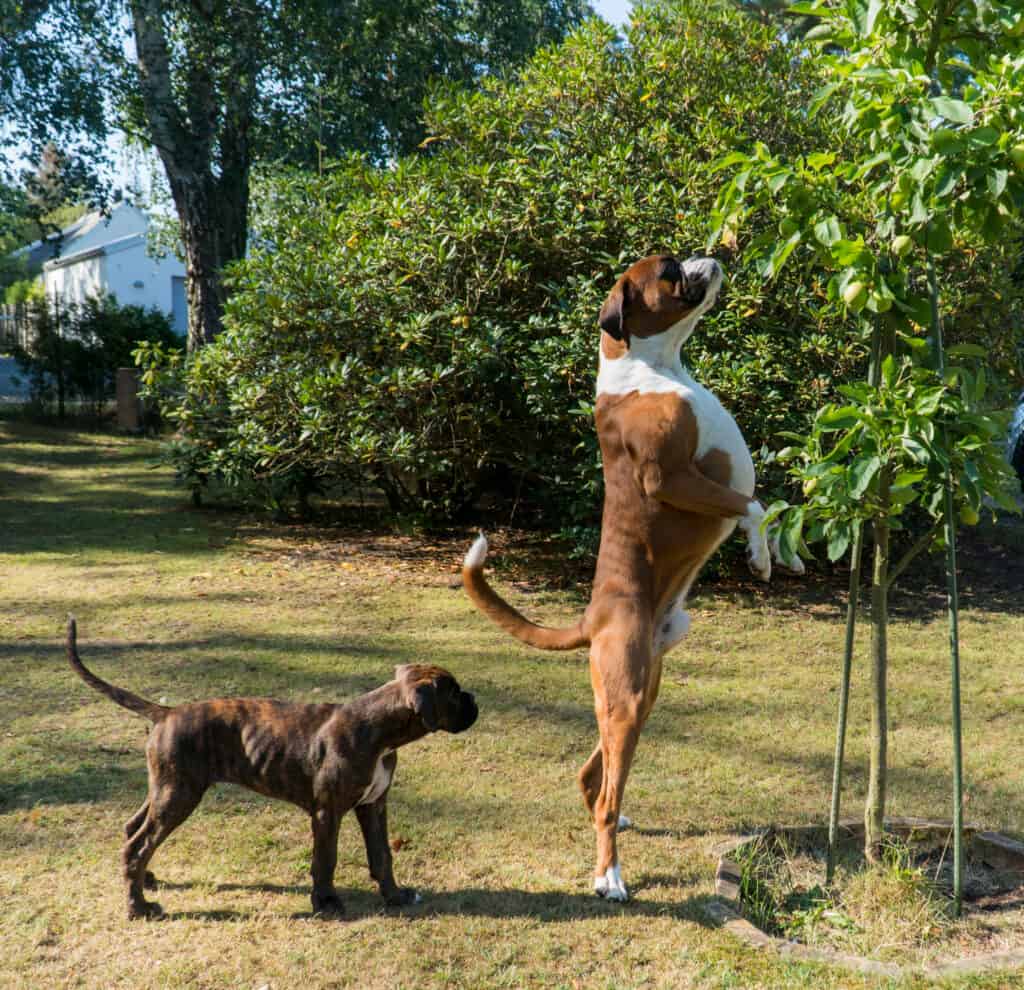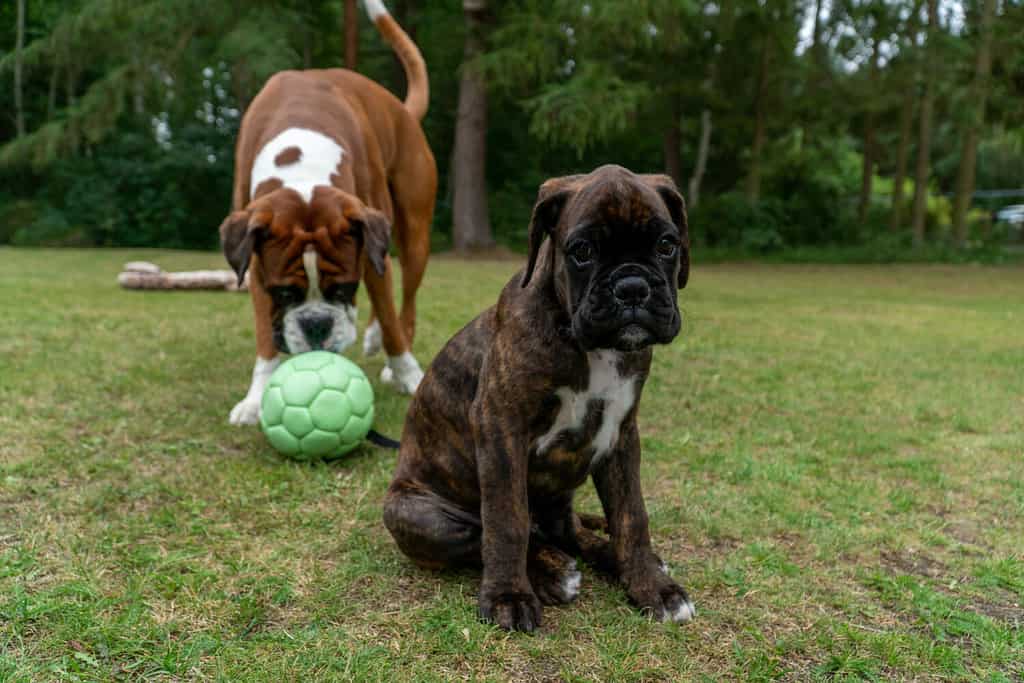
The name boxer is a result of their habit of standing on their hind legs and “boxing” with their front paws.
©Peter Roslund/Shutterstock.com
Boxers trace their roots to Munich, Germany in the late 19th century and are a cross between the extinct Bullenbeisser, used during hunting large game, and the English Bulldog. The name boxer is a result of their habit of standing on their hind legs and “boxing” with their front paws. This medium-sized dog has an athletic muscular build, a square head, and a short shiny coat. They range in size from 21-25 inches tall and weigh between 60-70 pounds. Cropped ears and docked tails are common. However, some opt to leave them natural. Regarded for their loyalty and playful nature they make great family pets. In fact, most will maintain their puppy-like nature most of their lives. They were the first military and police dogs prized for their courage, strength, and intelligence. Read on to find out everything about boxer exercise: energy level and how much activity they need.
How Much Exercise Is Enough?
On average they require about 2 hours of exercise a day. Puppies should be limited to 5 minutes of exercise for every month of their age. Lack of exercise can lead to weakness, muscle loss, and behavioral issues.
The Benefits of Exercise
Regular exercise keeps boxers healthy and well-behaved. It maintains muscle tone, prevents cancer, diabetes, and obesity, and reduces the risk of heart problems. Exercise alleviates boredom which minimizes behavioral problems that may result in destructive behavior and hyperactivity.
Boxer Exercise: Energy Level and How Much Activity They Need
Vary exercise routines with your boxer, mix up mental and physical activities to keep them engaged. Monitor how they respond to the level of exercise they receive to know if it should be increased or decreased. If they exhibit destructive or restless behavior after exercising it is an indication it needs to be increased. On the other hand, if they appear tired and disinterested in exercise cut back. Some types of activities they enjoy include walking, running, playing fetch, and agility training.
Walking
Taking a walk allows your boxer to socialize and sniff the flowers. And it creates an activity for them to look forward to doing with you. In addition, it provides excellent mental stimulation. Target about 30–40-minute walks divided into 15-20 minutes in the morning and 15-20 minutes in the afternoon. Be consistent and stick to a daily schedule. Playdates with other dogs or a visit to the dog park allow them to run around, burn off excess energy, and have fun.
Running
Boxers do well with short sprints rather than long runs because of their short snouts that cause breathing problems. However, they can be gradually trained to run longer distances. Take water breaks often to allow them to rehydrate. If they appear out of breath stop to enable them to get their breathing under control. They can be trained to run beside a bike or accompany you while skating.
Playing Fetch
Fetch is a great game for boxers, as they like to jump and sprint. It allows them to problem-solve as they seek the toy they are retrieving and provides mental stimulation. Please choose an area where they can run around and rotate between balls, frisbees, and other safe toys.
Agility Training
Activities that include weaving through poles, running through tunnels, or jumping hurdles provide great mental and physical stimulation. This exhaustive workout reinforces obedience training and creates a bond between you and your boxer. Agility training requires following instructions and focusing on you which promotes better communication and mental sharpness. A course can be set up in the backyard or you could join a club for a more challenging and structured experience.
The Importance of Mental Stimulation
Providing mental stimulation is just as important as physical exercise for a boxer. Keep them focused and engaged with puzzle toys and obedience training. An exercised boxer will be well-behaved, satisfied, and happy.
Optimal Times for Exercise
Exercising at the right time is important to your boxer. If done after eating it may result in digestive issues which can cause restlessness, abdominal tightness, or vomiting and may require a visit to the vet. Wait about an hour after eating, for more intense workouts wait about 2 hours for best results. A session in the morning and one in the afternoon is best practice. Limit activity to within an hour of sleep.
Exercising in Different Climates
Boxers are sensitive to temperature extremes due to their low fat content and short fur. The best time for exercising them is when the day is cooler during the summer months. During the winter they may require a coat to keep them warm and dry. Breathing is difficult for this brachycephalic breed, meaning they have a compressed skull. Specifically, their shorter, flatter faces have a harder time in hot and humid weather. For dogs with white spots on their coat apply sunscreen when out in the sun for more than an hour.
Over-Exercising and Heatstroke
Overdoing it, especially in warmer weather, can lead to heatstroke which may be life-threatening. With their short snouts boxers are more prone to overheating than some other breeds. Signs of heatstroke include vomiting, excessive drooling, elevated heart rate, labored breathing, severe panting, and sometimes sudden collapsing. If any of these signs present themselves discontinue exercise. Avoid exercising in the hottest time of the day which is late morning and early afternoon. Always provide a place with shade and water for them to rest and rehydrate.
Exercise for Boxers with Health Issues
Boxers with health issues such as hip dysplasia or heart conditions need modified exercise routines to adapt to their limitations. Exercises such as walking on softer surfaces or low-impact swimming can be easier for them. Consult a vet for advice on what is best for your boxer.
Exercise Injuries
Overdoing it can sometimes cause injuries such as joint damage, pulled muscles, and sprains. Most importantly, monitor exercise in puppies who are still growing and in older boxers who might have arthritis.
Monitoring During Exercise
Keep an eye on your boxer while exercising to ensure they are not under stress or overly tired. Regular vet appointments can alert you to any conditions that need to be monitored and adjust as needed.
Puppy Exercise

Boxer puppies need exercise too!
©Peter Roslund/Shutterstock.com
Puppies need exercise too! However, it is important to wait until their 3rd set of shots before taking them out in public. Up to this time they can play in the backyard away from other dogs. Merely 5 minutes a day of walking is enough to get them into the routine, increase to about 20 minutes a day. As they get older their activity level will increase as will the need for exercise. Overexercise in young boxers may cause bone and joint issues later in their lives.
Exercising an Older Boxer
An older boxer still needs to be exercised, just not as much. They may slow down on walks or lay around the house more. Pay attention to their cues and adjust accordingly, let them set the pace of their exercise routine. They may insist that they are still puppies so it’s important to help them realize what is best for them.
In Conclusion
Boxers make great companions and can be a great buddy to take along while you exercise. Keeping them in shape will make for a happier pet. It is important to understand their individual needs at each stage of their lives. Boxer exercise: energy level and how much activity they need is a guide to assist you on your journey with your best friend.
The photo featured at the top of this post is © Lenkadan/Shutterstock.com
Ready to discover the top 10 cutest dog breeds in the entire world?
How about the fastest dogs, the largest dogs and those that are -- quite frankly -- just the kindest dogs on the planet? Each day, AZ Animals sends out lists just like this to our thousands of email subscribers. And the best part? It's FREE. Join today by entering your email below.
Thank you for reading! Have some feedback for us? Contact the AZ Animals editorial team.






